Digital Tour with Antje Boetius
Nature as the solution – a utopia?
Hello, my name is Antje Boetius. I’m a marine biologist and the Director of the Alfred Wegener Institute in Bremerhaven. At Futurium, I want to find out together with you if nature is the solution to enabling a better life for us all and, of course, to making nature healthier. The exhibit named “Urban Jungle” shows the many small building blocks we already have at our disposal today. Join me on the digital tour of Futurium and discover mushrooms as building materials, and so-called “sponge cities” and algae as climate savers! Scroll away!
Floating blocks of flats, huge vegetable beds on several floors or houses made of mushrooms – this is what the urban world of tomorrow might look like.
© David von Becker
Bioplastics from trees or leather from apples: you’ll be amazed at what nature has to offer us in the way of alternative materials.
The mushroom is one of these wonders of nature. In the Futurium Lab, the exhibit “Mind the Fungi” shows what this living creature is capable of.
Did you know,
that you can lean more about the work of Antje Boetius in this podcast?
We’re still dependent on plastics for construction. Why don’t we pay much more attention to nature’s best building material? Namely wood. Even skyscrapers can be built with it.
The exhibit “Joyn Machine” shows how building with wood can be made possible for everyone.
Nature can help us fight climate change. Kelp forests, for example, are real climate savers. Why? I’ll explain it in the next video.
And researchers are also working on producing packaging from algae. Edible packaging!
Now let’s take a closer look at where humans can cooperate with nature. Cities provide a habitat for plants. At the same time, vegetation can make our life in cities more pleasant.
The sponge city is a concept of urban planning. Rainwater is absorbed and stored in the cities instead of merely being channelled and drained away.
However, cities can also serve as agricultural space. See for yourselves!
Did you know,
that Antje Boetius founded a theatre? The Theatre of the Anthropocene aims to make the consequences of our actions in the world experienceable and feelable.
One issue that occupies me in my daily work is marine life. Reefs serve as flood protection, but many of those made of mussels and oysters have disappeared. What if we humans were to help the sea rebuild them?
Did you know,
that at follow-polarstern.awi.de you can follow the Alfred Wegener Institute’s research vessel Polarstern in real time? Find out where it is and what the crew is experiencing on the expedition. Ahoy!
Did you know,
that at nordseelife.de you can explore the North Sea in an interactive map? Naturally, the voice on the website sounds as North German as it gets. 😉
In saving natural habitats, we can also rely on modern technologies – 3D printing, for example.
Did you know,
that you can support the work of the Swiss reef rescuers at rrreefs.com
Let’s stay in the water for a short time and look at a particular group of tiny creatures to be found there: plankton. They can provide us with information on how global change is altering the coastal ecosystem.
We can learn a lot from nature. Animals and plants are models for many of humankind’s technical inventions. There’s a special term for this: bionics.
art/beats
Let’s get started!
As you can see, nature has much to offer. There are lots of solutions that we’ve been using for thousands of years and can continue to use in the future. What struck me on this tour as clear as day was the thought: why do we need to wait a minute longer? Why don’t we just conquer the future and live this utopia that we can walk around in and let ourselves be inspired by? After all, it really is a matter of survival.



